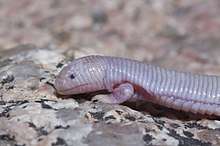Mexican mole lizard
| Mexican mole lizard | |
|---|---|
 | |
| Scientific classification | |
| Kingdom: | Animalia |
| Phylum: | Chordata |
| Class: | Reptilia |
| Order: | Squamata |
| Family: | Bipedidae |
| Genus: | Bipes |
| Species: | B. biporous |
| Binomial name | |
| Bipes biporous (Cope, 1894) | |
| Synonyms | |
The Mexican mole lizard (Bipes biporus), commonly known as the five-toed worm lizard, or simply as Bipes, is a species of amphisbaenian,[2] which is endemic to the Baja California Peninsula. It is one of four species of amphisbaenians that have legs. It should not be confused with the axolotl, a salamander (Ambystoma mexicanum), which is usually called ajolote in Spanish. It is commonly found in Baja California.
Description
They are pink, worm-like lizards, 18–24 cm (7.1–9.4 in) snout-to-vent length and 6–7 mm (0.24–0.28 in) in width, that live for one to two years. Their skin is closely segmented to give a corrugated appearance, and like earthworms, their underground movement is by peristalsis of the segments. Blunt heads allow them to burrow into sandy soils efficiently. The forelegs are strong and paddle-like, while the hindlegs have disappeared, leaving behind only vestigial bones visible in X-rays.[2] The tail on these worm-like lizards are autotomous without any regeneration.
Reproduction
This species is oviparous and the females lay one to four eggs in July. The species only breeds underground. The eggs hatch after two months.
Geographic range
The Mexican mole lizard (B. biporus) is found in the states of Baja California, Baja California Sur, Guerrero and Chiapas, in Mexico.
Behavior
Like all other amphisbaenians, this burrowing species only surfaces at night or after heavy rain. It uses its autotomous tail as an escape tatic for predators. Losing a part of the tail while burrowing can plug up the hole behind it, giving it time to escape from any kind of predator that might be chasing it down.
Diet
It is an opportunist carnivore and eats ants, termites, ground-dwelling insects, larvae, earthworms, and small animals including lizards. It usually pulls its prey under ground to start its meal.
References
- ↑ Stejneger, L., and T. Barbour. 1917. A Check List of North American Amphibians and Reptiles. Harvard University Press. Cambridge, Massachusetts. 125 pp. (Bipes biporus, p. 72.)
- 1 2 "Absurd Creature of the Week: The Adorable Mexican Mole Lizard Has a Disgusting Reputation".
this is one of the strangest, most mysterious reptiles on Earth (it technically isn’t a lizard or a snake, but sits in a category all its own, the amphisbaenians), with powerful front limbs and rear limbs that have vanished save for vestigial bones you can only make out on X-rays.
Further reading
- Cope, E.D. 1894. On the Genera and Species of Euchirotidæ. American Naturalist 28: 436-437. (Euchirotes biporus)
- Stebbins, R. C. 2003. A Field Guide to Western Reptiles and Amphibians, Third Edition. The Peterson Field Guide Series. Houghton Mifflin. Boston and New York. xiii + 533 pp. ISBN 0-395-98272-3 (paperback). (Bipes biporus, pp. 428–429 + Plate 55 + Map 200.)
External links
- http://animals.jrank.org/pages/3700/Mole-Limbed-Wormlizards-Bipedidae-TWO-LEGGED-WORMLIZARD-Bipes-biporus-SPECIES-ACCOUNT.html
- https://web.archive.org/web/20100306174613/http://animaldiversity.ummz.umich.edu/site/accounts/classification/path/Bipes_biporus.html#Bipes%20biporus
- Bipes biporus at the Reptile Database
- Photos and videos of the Bipes biporus
